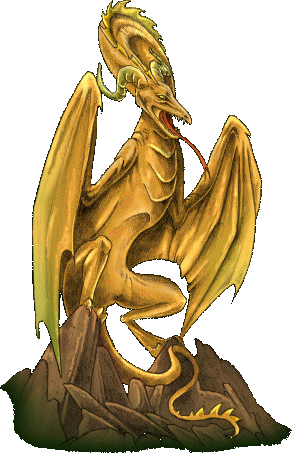Classified 'Dragon'
Why there are so many different creatures called 'dragons'? The word 'dragon' is an umbrella term, encapsulating all manner of creatures, from mythic serpents to monstrous hybrids. As a class of supernatural being, creatures classified as dragons possess some combination of related traits, major and secondary.
Major Traits
Major traits are common to creatures classified as dragons; some of them can unify dragons in terms of appearance or behavior. Others make certain dragons stand out. The major traits are the most likely traits to a dragon.
Major Trait: Reptilian Attributes
Reptilian traits are the most common physical elements associated with dragon. Dragons often have the attributes of serpents, lizards, and/or crocodiles, including the following:
- scales
- tail of a serpent
- head of a serpent
- wedge-shaped head (i.e. head of a crocodile)
- low-slung reptilian body
- short legs of a lizard
Beyond the physical aspect, reptilian behavior can appear in regards to dragons with descriptions such as 'with the speed of a lizard,' 'scales as thick as a crocodile,' or 'crawling like a serpent.'
The lore surrounding reptiles is also reflected in dragons. Many groups imbued the snake with fantastical healing powers, or even immortality, because they slough their skin almost entirely as one unit; similarly, the dragon can have supernatural healing abilities or be the keeper of the secrets of medicine.
Major Trait: Flight
The ability to fly represents freedom and spiritual enlightenment; for example, birds like the eagle or the hawk symbolize heavenly power over the physical temptations of the world. Some dragons possess the ability to leave the earth by flying. A dragon with the combined elements of the ability to fly and reptilian traits represents the combination of the heavens and earth, the bird and the serpent, this life and the afterlife.
Flying dragons might have wings, but in some instances, the ability to fly comes from a magical object or blessing. For example, some Eastern dragons carry a po'shan, which enables them to fly.
Major Trait: Connection to Water
From antiquity, dragons have been associated with water, be it with rain and drought or a particular body of water. Dragons that control the rains or the weather are embodiments of the earth's natural elements.
Dangerous bodies of water, such as waterfalls, tidal bores, and whirlpools, are often considered the homes or hunting grounds of dragons. The menace associated with this kinds of dangers implies a considerable amount of power attributed to dragons.
Major Trait: Supernatural Powers
Beyond the ability to control natural elements or fly without wings, dragons also present with supernatural powers. Supernatural powers are what set dragons apart from other animals. A large serpent or a crocodile would not a dragon make unless imbued with additional powers.
This could be the ability to speak to humans or the power to lure humans as prey. Other examples of supernatural powers include the ability to transform into other beings, casting spells, divination, and super-strength.
Major Trait: Toxic Breath or Fumes
A specialized form of supernatural power, dragons may possess toxic breath or fumes, such as spitting fire, spewing torrents of water, and spraying poison. Likely, the idea of toxic or fiery breath stems from the noxious nature of particularly potent venom.
In nature, certain serpents can spit their poison to cause temporary blindness. Some amphibians possess toxins in the skin that poison those who try to handle them. The fumes emanating from a dragon would corrupt the waters it drinks from, desiccate the vegetation it lurks by, and kill anyone who tries to get too close.
Secondary Traits
Secondary traits are less commonly associated with dragons. These tend to be specific to the region or mythology of the dragon in question.
- Connection to the Weather or Natural Phenomena
- Avian Attributes
- Guardians and Emissaries
- Connection to Deities and Status
Secondary Trait: Connection to the Weather or Natural Phenomena
Power over the rain is more common then power over the weather or natural phenomena. Weather-related power include power over lighting and thunder, hailstorms, hurricanes, tornados, or sandstorms; similarly, power over natural phenomena includes earthquakes, volcanic eruptions, and forest fires.
Dragons imbued with this kind of power usually relate to deities of the earth or weather. Particularly dangerous areas, such as an active volcano or a volatile hot spring, might be the abode of a dragon. Trespassing would offend either the dragon itself or a deity, triggering the wrath of the dragon.
Secondary Trait: Avian Attributes
Physiological traits from birds are somewhat common among dragons. Examples include as follows:
- feathered wings
- feathers or crests
- avian claws or legs
- avian beaks
- bird cries or calls
Non-physiological avian elements, such as the menacing cry of a night bird or the hunting prowess of hawks, can also be attributed to dragons.
Secondary Trait: Guardians and Emissaries
Dragons often have a specific purpose. They could be sacred or precious to a particular deity, as in the deity's messenger, relative, or even a kind of pet. The most likely scenario presents the dragon as a guardian, whether it protects a sacred place, a town, a particular treasure, a family or family member, or even a profound secret.
Some dragons act as natural guardians. No specific deity or spirit assigns them to protect anything; instead, their inner nature drives them to protect something.
Secondary Trait: Connection to Deities and Status
Dragons sometimes have a tremendous amount of power and respect, usually derived from spirits and deities. Sometimes they serve mortals of great power, but a dragon is more likely to serve a supernatural being.
High rank or high status attributed to a creature can indicate a creature as a dragon. For example, some claim that the dragon is the king of serpents or the king of lizards.

